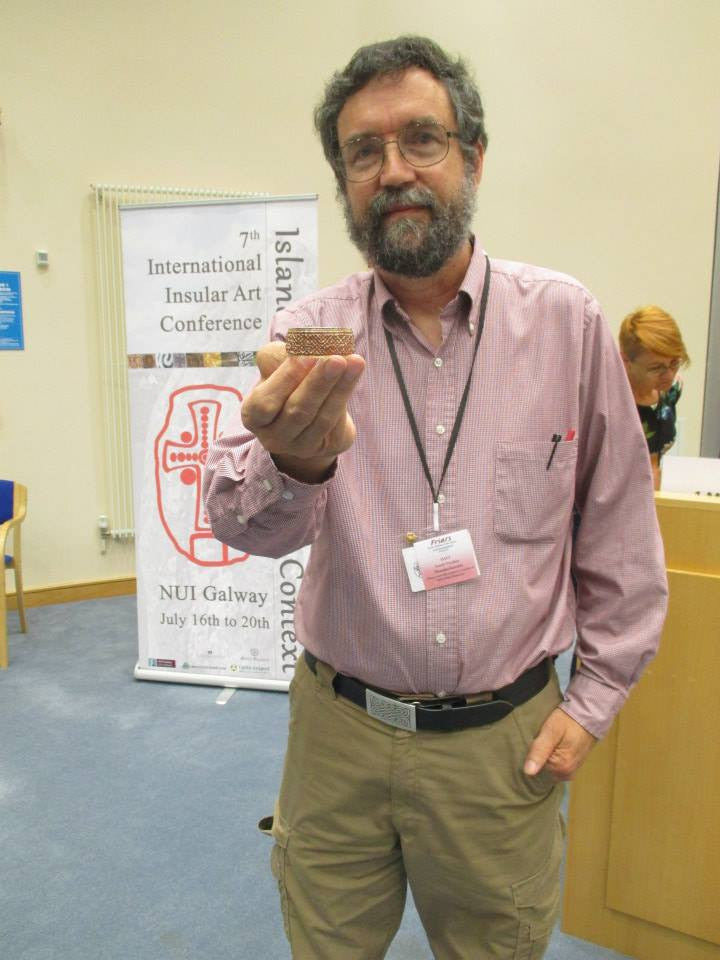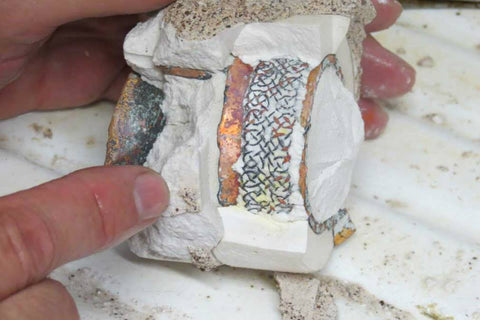- Jewelry
- Crosses
- Rings
- Mens
- Claddagh
- Wedding
- Personalized Jewelry
- John Urban Jewelry
- Sale
- Gift Certificates
- About Us
August 12, 2014

American Celtic Jeweler Stephen Walker presented a demonstration and discussion at an international gathering of Celtic Art experts at the National University of Ireland in Galway on July 19, 2014. Walker’s topic is the Ardagh Chalice, an extremely elaborate bit of metalwork from 8th century Ireland, now displayed at the National Museum of Ireland. The chip-carved decoration of the stem of this masterpiece has long been a puzzle to both historical researchers and modern craftsmen. Walker developed a theory about how the mold was made to cast the intricate, deeply carved interlace with 396 crossings in an area just under 13 square centimeters. Walker then hand carved a similar mold and cast a replica in bronze using only simple tools and materials that would have been available to early medieval Celtic craftsmen.

The International Insular Art Conference is held at different locations every three to five years. This year the thirty nine presenters include historians, curators and archaeologists from Trinity College, The National Museums of Ireland and Scotland as well as other Irish and international scholars.

Walker discussed the three most common theories about cast chip-carving, or “kerbschnitt” as scholars often refer to it. Many consider it to have been made by taking clay impressions from models carved in another material using the same chip carving technique used by wood craftsmen. Others have presumed lost-wax casting or directly carving in the metal after the shape is cast. Walker showed how each of these methods were used for some medieval pieces but that a more direct technique of carving the mold rather than first making a positive model is a simpler and more plausible explanation for most of the cast kerbschnitt material.

The interlace and spiral designs created in this manner were a central feature of Celtic metalwork during the “Golden Age” from the 7th to the 10th centuries. Walker explains, “There was a lull in the production of high status metalwork after the Viking raids of the 9th century. By the 11th century the kerbschnitt technique was replaced by other methods of rendering Celtic ornament. So this really is a ‘lost art’ that went out of practice over a thousand years ago.”

Walker Metalsmiths has stores in Andover, NY and Fairport, NY. Four full time craftsmen are employed creating their own in-house line of gold and silver contemporary and traditional Celtic jewelry. They also offer the work of several of the finest Celtic jewelers from Ireland and Scotland. For more information go to WalkersCelticJewelry.com.
Find Stephen on Google+
Comments will be approved before showing up.

July 19, 2025
Many people don’t understand that this kind of small-town life still exists in America. You might think in stereotypes like Mayberry, but there aren’t really towns like that anymore, are there? Not Mayberry exactly, but yes, something similar and half a century later.

June 05, 2025
Ai”, has crashed the Celtic Festival, drunk, pushy, and getting in everyone’s face with some of the most obnoxious and un-authentic Celtic art of all time

May 30, 2025
We have included our favorite tips & tricks to get those improvised engagement photos looking like a professional photographer was hiding in the bushes.
Sign up to get the latest on sales, new releases and more …
Monday-Friday 9-5
Saturday 10-3
